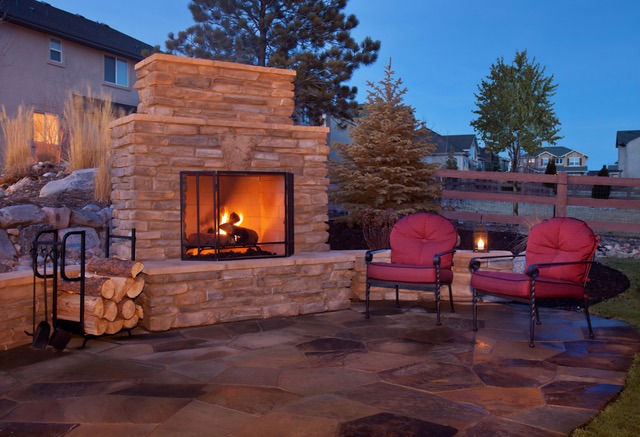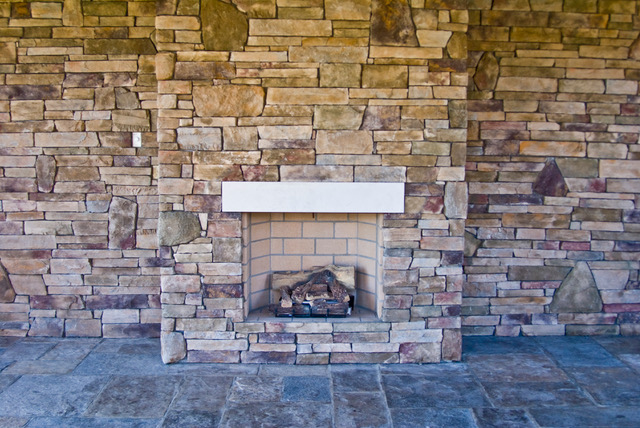Words: Joanne M. Anderson
Photos: Dorin_S, Oneillbro
The warmth of a fireplace is both literal and figurative, and it remains one of the top three accoutrèments in a house on the home buyer’s list. Some 60% of new homes have a fireplace, which is up from 36% in the 1970s, according to homeguides.com. Fireplaces are not especially factored into a home appraisal, but estimates run up to $12,000 in added value to a property. About half of home buyers are willing to pay extra for having a fireplace in the home.
Of course, in colonial times, close to our spot on 100% of homes had fireplaces and/or woodstoves, as they supplied both heat and often the main source for cooking and baking. In the early days of our country, fireplaces were small. Then they were enlarged to as much as 10 feet wide, being much wider than deep. The large fireplaces often included an oven in the back or off to one side, as well as spits and hinged cast iron arms for hanging pots and kettles. Rarely would you find a large fire in any of the big fireplaces? More often, there would be small fires, like for cooking on high, medium and simmer. When wood sources began to deplete in some regions, the fireplaces became smaller again.
Central chimneys in colonial homes were practical for having several flues opening into different rooms on different floors for heat in many rooms of the house. The chimney in the middle retained heat as well. By the mid-18th century, mantles and decorative wood paneling were added for style. Around 1795, Count Rumford (aka Sir Benjamin Thompson) dinked around with fireplace design, determining it was more functional being taller than it is wide and smaller and more shallow to reflect more heat. His work laid the foundation of fireplace design.
Fireplaces were and still are the heart of the home, as people – then and now – gather where there is food and warmth. Flickering flames – appropriately contained inside a fireplace – have a relaxing, even mesmerizing, effect. They are cozy and romantic, and wood or gas works when the power goes out. The snap, crackle, and pop of ultra-dry wood burning is comforting as well, and wood burning fireplaces still rank at the top of fireplace preferences.
Brick and natural stone are the most popular fireplace materials for their strength, durability and timeless appeal. Both come from all natural sources and are totally recyclable. Brick is less expensive and priced by the brick. Stone prices are calculated by weight, and it’s wise to buy some extra in the event of repair work. Most stonework is finished with a sealant to prevent soot and stains on it, and cleaning is simple with a damp cloth. Brick is too porous to seal. Brick and stone fireplaces have a potential lifespan of 100 years, so it’s a wonderful investment or addition, though adding a fireplace costs much more than having it built the same time as the house.
Outside Wall
Possibly the most common place to find a fireplace is on an exterior wall, usually in a living room, family room or great room, with the chimney hugging the exterior side. Usually the brick or stone matches inside and out, with the chimney extending above the roof. The interior masonry work varies immensely in volume and color. Some brick or stone goes right to the ceiling, and others are placed around five feet wide and five feet tall, give or take, including the hearth and mantle. There are as many variations in masonry work on fireplaces as they are kinds and colors of stone and brick.
Timber frame, log and rustic Adirondack style homes are renown for soaring stone fireplaces. Brick is almost exclusively found in traditional and colonial style houses. Bricks come in the same size, making them easier for the professional stone mason to work with and less expensive for the overall job. One good stone mason can build any brick fireplace and chimney. Part of the appeal of stonework is the variation in color and size, along with the natural element. It is, however, a much more labor-intensive process often requiring two workers. Each stone is hand-selected, then cut and chiseled for the perfect fit into the overall scheme.
Corner
The majority of corner heating and ambiance fireplaces are really wood stoves with a stone or brick hearth and surround. It is then vented through an exterior wall or the ceiling and roof. It behooves stonemasons to drop off business cards and make friends with all the local or regional wood stove vendors for all those fireproof hearths and walls. It also makes sense to come up to speed on town, city, county and state building codes. There’s no work without appropriate permits and detailed, approved plans to meet local codes and ordinances. Buying the wood stove, in fact, is the easy part. Construction of the stone or brick corners for function and style is more challenging, as well as the flue and chimney parts.
Center
A center fireplace and chimney make a dramatic statement in any home, and one bonus is often two fireplaces facing two rooms on both sides of the same chimney. It is the perfect location for anyone living off the grid and makes a great heating supplement to any building as well. There’s probably more clean-up hauling wood to the center of the room, but hey, that’s a small trade-off for the impressive aesthetic and potential reduction in energy costs.
Outdoors
The backyard fireplace is a standing masonry unit with a firebox, not to be confused with those charming rings of fire known as fire pits. They are either on the ground wrapped with a circle of stone or brick or inside a stand-alone metal housing. With outdoor living amenities expanding across the country, the outdoor fireplace or fire pit can have the same powerful draw as its indoor cousin. “Brick is the perfect material for both outdoor fireplaces and fire pits as it doesn’t burn, and its color will not fade over time,” states Stephen Sears, COO of The Brick Industry Association. “And bricks provide a time-honored ambiance that is just not matched by other materials.”
Lots of outdoor living concepts are add-ons to an existing home, so it’s another great opportunity for stonemasons to network with remodeling companies. Stonemasons can cozy up to landscaping professionals and outdoor living designers to be first in line for outdoor fireplaces, brick ovens, fire pits, brick and stone patios, walls and benches.
Fireplace Facelift
If you purchased a home with an older fireplace, now may be the perfect time for a fireplace facelift. Lightweight stones can add rustic charm to any hearth, or a Victorian style mantle in marble or slate could be just the look you wish to achieve. With varieties of fireplace and mantel designs too numerous to count, you can choose the look that is perfect for your home. Carved limestone, marble, flat stones, rounded boulders, or coarse volcanic rock can be chosen to match the color scheme and feel of your home. Different designs such as colonial, contemporary, rustic, log cabin, modern or old world are just a few choices. And it is not only the type of stone that you choose but the color, shape, and design of your fireplace and mantel that will create the final work of art. [staincrete.com]
Changing the mantle, adding bookcases or shelves on the sides, painting brick, new screen, and fireplace tools, adding fancy andirons or a tile surround are some ways to change the look. Installing glass doors or a fireplace insert can dramatically improve efficiency. In old houses or where a fireplace is used as a primary source of heat, all the mortar joints inside and out of the firebox should be inspected and repaired as needed.
Innovation
One new spin on the fireplace stage is the ventless model which can burn gas or propane, but more commonly uses gel, plant-based fuel or an ethanol product. Hearth Cabinets, based in New York City and made by New York craftsmen, views its products as “the safest fireplace in the world.” They were designed by a team which included Michael Weinberger, an inventor and product liability attorney, and Arthur Lasky, an architect, and designer. Their goal was to create an innovative fireplace solution for homes and buildings which cannot adhere to building codes for standard fireplaces, flues, and chimneys. No doubt, there are plenty of those kinds of residences in big cities.
The Hearth Cabinet ventless fireplaces employ a Locked Safety ScreenTM, which protects anyone from getting to the flame once the screen is locked in place, and patented Safety Gel Cartridges™ for fuel. These alcohol gel fuel cartridges burn cleanly, so there are no requirements for electricity, a gas line or flue or chimney. At the moment, they are (according to its website) the only ventless fireplaces approved for use in the Big Apple by both the New York City building and fire departments.
Mason-Lite manufactures prefabricated indoor and outdoor masonry fireplace kits and prefabricated fireplaces for burning wood or using gas. Three business partners bring more than a century of experience to the company, and all products are American made. On the cutting edge of fireplace design, Mason-Lite also has a contemporary line of linear fireplaces from 48 to 120 inches. The trend is especially popular for the convenience of turning one on and off with a button and having real looking fire flames. Linear fireplaces are attractive where space is limited because they can be installed into a wall, and routine maintenance is far less than a wood burning fireplace.
Award-winning stonemason Lew French collects hundreds of stones for a single fireplace or stone wall. He does not use a chisel but fits them in his mind’s eye before assembling the project naturally. He has been inducted into the New England Design Hall of Fame and has published two books with creative and inspiring ideas for fireplace design:
“Stone by Design: The Artistry of Lew French”
“Sticks and Stones: The Designs of Lew French”
“Invest in the timeless beauty of brick and stone. It has warmth and human scale. Put into place by hand, one by one, only brick or stone gives that touch of craftsmanship, authenticity and timeless durability. More types of brick, stone, and block are now available than ever before. Modern steel reinforced masonry structures are both durable and safe. Masonry structures can easily be designed to withstand high winds and earthquakes. Brick, block, and stone will not burn and insects cannot destroy them, and the final masonry product is very low maintenance with a long service life.” [www.finnhillmasonry.com]
There’s a fireplace for every personality and every house style. Restaurants and hotel lobbies with a fireplace captivate and welcome guests with a wow factor. A fireplace where the brick and stonework was placed by the hands of a fine stone mason is unrivaled for authentic beauty and sophisticated expression. It speaks softly of fine craftsmanship and enduring quality.



